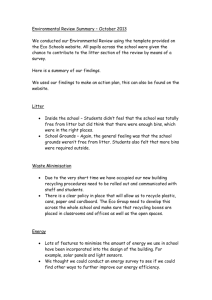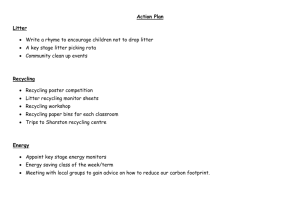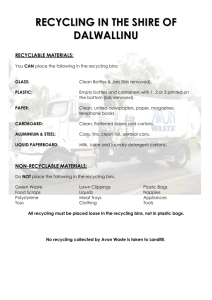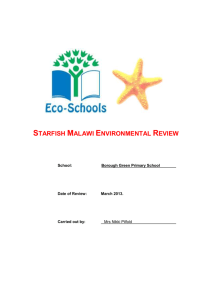West Wallsend Public School Environmental Management Plan
advertisement
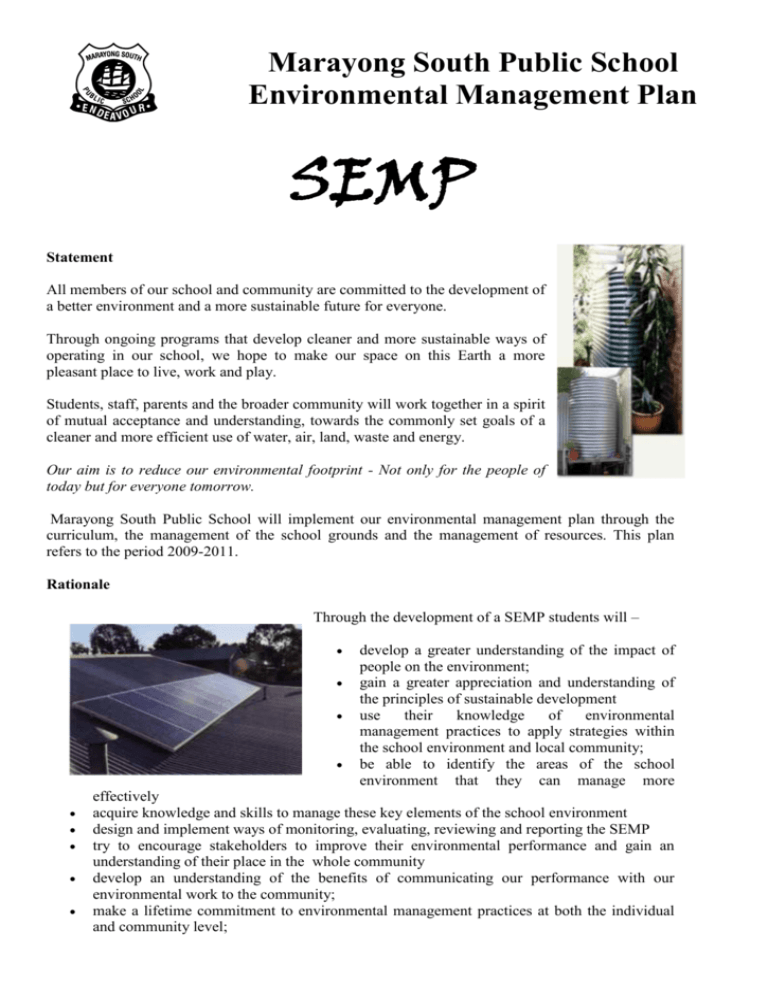
Marayong South Public School Environmental Management Plan SEMP Statement All members of our school and community are committed to the development of a better environment and a more sustainable future for everyone. Through ongoing programs that develop cleaner and more sustainable ways of operating in our school, we hope to make our space on this Earth a more pleasant place to live, work and play. Students, staff, parents and the broader community will work together in a spirit of mutual acceptance and understanding, towards the commonly set goals of a cleaner and more efficient use of water, air, land, waste and energy. Our aim is to reduce our environmental footprint - Not only for the people of today but for everyone tomorrow. Marayong South Public School will implement our environmental management plan through the curriculum, the management of the school grounds and the management of resources. This plan refers to the period 2009-2011. Rationale Through the development of a SEMP students will – develop a greater understanding of the impact of people on the environment; gain a greater appreciation and understanding of the principles of sustainable development use their knowledge of environmental management practices to apply strategies within the school environment and local community; be able to identify the areas of the school environment that they can manage more effectively acquire knowledge and skills to manage these key elements of the school environment design and implement ways of monitoring, evaluating, reviewing and reporting the SEMP try to encourage stakeholders to improve their environmental performance and gain an understanding of their place in the whole community develop an understanding of the benefits of communicating our performance with our environmental work to the community; make a lifetime commitment to environmental management practices at both the individual and community level; It encompasses 3 areas: Curriculum Management of Resources Management of School Grounds Curriculum 1. Our school Environmental Education Contact Person will lead and work with other teachers in this area. 2. Audit – evaluate the school curriculum. Identify related outcomes and content from each KLA for teaching and learning. 3. Identify and develop strategies to address student values and attitudes towards the environment 4. Participate in special environmental events, days, programs and excursions (Landcare, National Clean-up Day, Tree Day, Greening Australia, River Care, Land and Water Conservation, Local Government, National Parks and others) 5. Develop a data base of native birds and animals in the school environment. Management of Resources – Avoid, Reduce, Reuse and Recycle Pate Cooper, Principal will lead and work with Bev Brown (School Environmental Education Contact Person), the Environmental Committee and the whole school community in this area to:1. Monitor the use of resources and utilities. 2. Develop and institute a list of strategies for improving the management and use of resources – Electricity – Each class will appoint a monitor to ensure that power is not wasted e.g. turn lights off when room not in use, close windows and doors when running air-conditioning (or gas), computers turned off over weekends etc. Sensor lights installed in toilets and installation of energy efficient tubes according to the availability of funds. Products and materials – reuse and recycle. Water – harvest stormwater for gardens, monitor taps for drips, labels to promote conservation of water, encourage best practices in the classroom (e.g. use a bucket to wash paint brushes, etc.) Waste – reuse, recycle, composting, worm farming. 3. Apply for funding from the Solar Schools Program to : Install rainwater tanks (near hall and HB1 ) Run solar powered pumps. Management of school grounds 1. Pate Cooper (principal), Alan Martin (GA) and Bev Brown (School Environmental Education Contact Person) will work with MSPS Environmental Committee, staff, students and community members in this area. 2. The school will identify main aspects in the school grounds for environmental improvement 3. Establish adequate measures to deter domestic and native animal problems (bird proofing bins, mice/rat control, white ants, fleas) 4. Develop and institute a list of strategies for improving the management and use of the school grounds (biodiversity, soil, noise, litter, shade, human traffic, dust, visual amenity, stormwater, who uses the school grounds, watering regimes, weed control) 5. Utilise and develop buildings and grounds as learning areas. 6. Establish native animal friendly areas eg bushy native trees and plants 7. Plant natives which are suited to the local environment. Consider health and safety issues (landscaping, hay fever, falling branches, thorns, location, longevity, root systems, compatibility with lawns…) 8. Maintain current gardens at the front of the school, along driveway and carpark and between Block B and C as these enhance the appearance of the school. 9. Establish water wise garden between the Library block and Block C using suitable plants and mulches. 10. Establish vegetable gardens in fenced off area along back fence. 11. Replant Bush Tucka Garden and plant a line of trees along back fence. 12. Recycling – Continue with Visy paper recycling. Hire yellow bins from BCC for recycling of paper, plastic etc. from canteen. 13. Establish worm farms and composting bins 14. Establish contact with BCC re MSPS taking a role in caring for the bush in Doonside Cr Reserve. Action Plans:– Action plans will be developed in the areas of Curriculum, Management of Resources and Management of Grounds as required. Evaluation:Evaluation is an important aspect of any plan. This may take the following formats: Ongoing monitoring of changing attitudes of students. Ongoing observation and monitoring of litter levels in the playground Awareness and knowledge of levels of issues involved. Observation of student participation and outcomes of teaching/learning. Surveys Visible development of school grounds Observation of the sustainable initiatives employed under schemes such as the Solar Schools Program and the positive impacts of those initiatives. Data collection strategies used to determine levels of resource usage and environmental care. 1. Paper use ~ comparing paper usage and recycling levels from 2008 to 2009/10/11 2. Water use ~ comparing water usage levels from 2008 to 2009/10/11 3. School litter surveys ~ assess amount of litter in the playground and how much is put in the yellow BCC recycling bins. 4. Level of recycling in the school ~ number of paper recycling pickups; other areas for recycling noted. 5. Aesthetics of the playground ~ Feedback from visitors to the school and from community members. Proposed Timetable 2009 2010 2011 ? Form a MSPS Environmental Committee comprising:Principal, Contact Person, teachers, GA, Cleaner, students, parents and students. Gardening Club to be organised. Purchase and install labels for taps. Class Monitors to be appointed. Organise BCC recycling bins. Students will need to be educated on the correct procedures. Apply for Solar Schools Program Grant and subsequent installation of water tanks. Replant garden between library and block with low-growing, waterwise plants. Replant Bush Tucka garden and line of trees along back fence Purchase composting bins and worm farms Organise the collection of foodscraps for above. Establish and plant vegetable garden. Install sensor lights in toilets and installation of energy efficient fluorescent tubes. School to take an active role in caring for Doonside Cres. Reserve when it is handed over to BCC. Policy drafted December 2008. Implementation 2009 -2011

